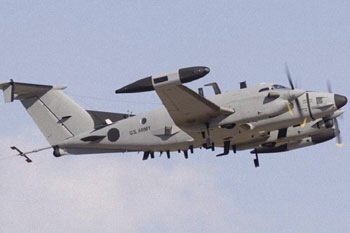DRS Unveils Very Small SIGINT Sensor
Posted on
WASHINGTON: Imagine reconnaissance teams operating in enemy territory being able to hump in their own tiny signals intelligence (SIGINT) sensors, able to gather intel on both electronic emissions (ELINT) and communications (COMINT). Ok, they don’t have to hump them in because each one weighs roughly two-and-half pounds. Sound like science fiction?
Well, DRS, the American subsidiary of Finmeccanica, has unveiled what it claims is the world’s smallest SIGINT package — roughly the size of a small self-contained hard drive. When I saw this thing, called Polaris, sitting on a table at the DRS booth during the Association of Old Crow’s annual conference, I was (in the Australian vernacular) gobsmacked.
It is ruggedized to cope with the bangs and bumps of combat. The company has already got an “American customer,” but the VP for SIGINT business development, Stephen Robillard, smiled and declined to identify it any more closely. Your guess is probably as good as mine — Special Operations Command or a close relative.
DRS already made one of the world’s smallest SIGINT sensors, but this is a quarter the size, boasts twice the frequency coverage and offers twice the bandwidth. Ah, the miracle of cooler and smaller computer chips.
For decades, signals intelligence (SIGINT) sensors came in pretty big packages: big satellites; big satellite dishes, big planes like Compass Call and Global Hawk and smaller aircraft like the U-2 or Guardraii.
These sensors needed sizable power sources and needed bigger platforms to carry them or support them. If you can combine dozens or hundred of SIGINT sensors across a battlefield — carried by SOCOM teams, slapped onto Abrams tanks, Bradley personnel carriers, Kiowa Warriors and Apaches — with the much-lower density systems such as Global Hawk, Compass Call, and satellites, you can achieve remarkable accuracy and provide the Intelligence Community with an enormous amount of data to crunch.
Most of the market for the Polaris may be commercial, Robillard said. The units can be used by the FAA and FCC or companies to monitor for signals that might jam GPS, for example. He estimated the overall market’s size in the “tens of millions” over the next five years.
Subscribe to our newsletter
Promotions, new products and sales. Directly to your inbox.

